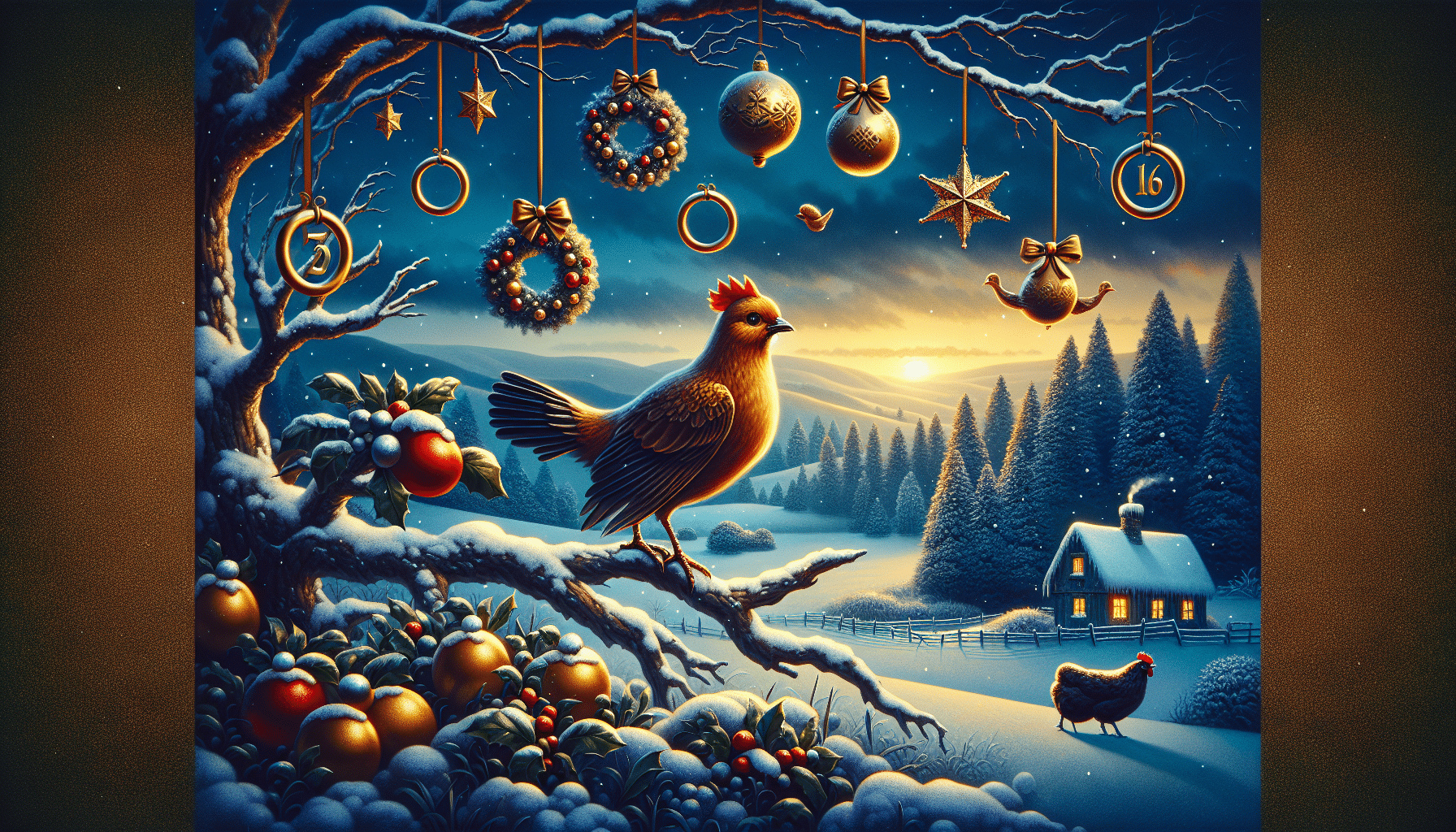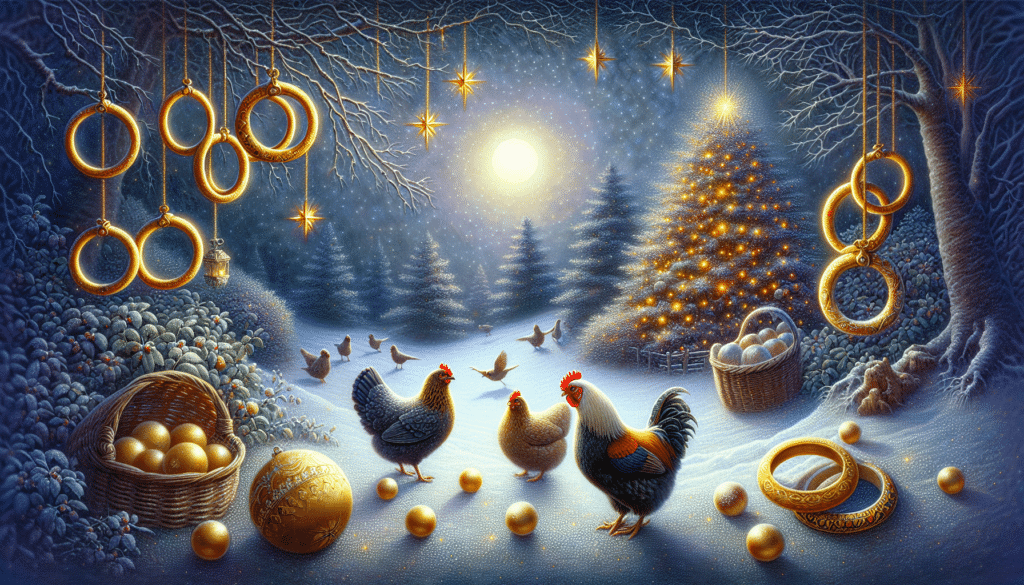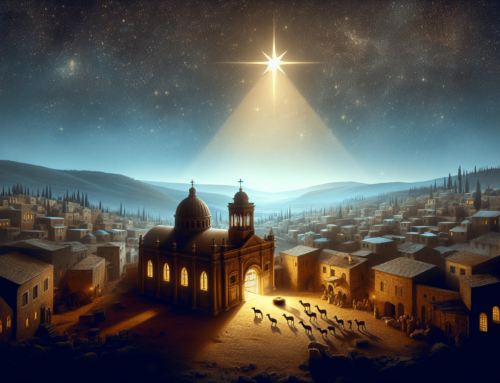What Are The True 12 Days Of Christmas?

Imagine being swept up in the magic and merriment of the holiday season, where twinkling lights dance across frosty windows and the scent of gingerbread fills the air. In the heart of this festive wonder lies a tradition as rich and as sweet as a slice of fruitcake: the true 12 Days of Christmas. This storied period isn’t just a catchy tune we all find ourselves humming along to; it’s a historical tapestry woven with cultural significance and celebration. Let’s unwrap the layers of this yuletide custom together, revealing the origins and the age-old practices that define the true 12 Days of Christmas, a time-honored sequence that holds more than partridges and pear trees in its branches.
Understanding the 12 Days of Christmas
Origins of the 12 Days of Christmas tradition
You may have heard of the “12 Days of Christmas” and thought of them as the days leading up to Christmas Day, but in fact, the tradition starts on Christmas Day itself and continues until the eve of the Feast of the Epiphany. The origins of this Christian tradition can be traced back to the early church, where the span of days was a continuous celebratory period marking the birth of Jesus Christ.
Difference between Advent and the 12 Days
It’s easy to get Advent confused with the 12 Days of Christmas. Advent precedes Christmas and is a time of preparation and anticipation, beginning four Sundays before Christmas Day and ending on Christmas Eve. The 12 Days, on the other hand, start on Christmas Day and represent a time of celebration.
Modern misconceptions and clarifications
You might assume that the 12 Days of Christmas are named for the famous carol, but it’s the other way around; the song was inspired by the festivities. Moreover, some people erroneously believe that the 12 days lead up to December 25, while in reality, this period follows it. Correcting this misconception ensures a better appreciation for this historic period.
Historical Significance
The 12 Days in Christian history
In Christian history, the 12 Days have always been a significant period to commemorate the birth of Jesus Christ and reflect on his coming into the world. This time was also integral in setting the stage for the coming year’s liturgical calendar, especially with the anticipation of Epiphany.
Cultural variations across different countries
The way the 12 Days are celebrated varies widely across different cultures, with each country adding its own unique traditions and customs. Some countries emphasize certain days more than others, and the festivities can range from solemn religious observances to exuberant communal celebrations.
Evolution from religious to popular culture
Over time, the 12 Days have evolved from a purely religious observance to a part of popular culture. The period is still firmly rooted in its Christian origins, but various elements have been adapted to fit the times, and the essence of celebration has been retained even in secular circles.
Biblical Connections
Potential biblical roots and interpretations
Although the Bible does not explicitly mention the celebration of the 12 Days, scholars believe that this period has potential biblical roots and interpretations. This can be seen in the intervals between Christ’s birth and certain events recognized by the church, such as the arrival of the Magi, which is commemorated during Epiphany.
Symbolism of the number 12 in Christianity
The number 12 carries deep religious significance in Christianity, symbolizing completeness and divine authority. There were 12 tribes of Israel, and Jesus had 12 apostles, reinforcing the importance of the number in the foundation of Christian traditions.
Nativity narrative and the Christmas season
The nativity narrative, which describes the birth of Jesus Christ, is at the heart of the Christmas season and the 12 Days tradition. This period gives you a chance to delve deeper into the lesser-explored aspects of the story and its key messages of hope, joy, and salvation.
The Liturgical Calendar
How the 12 Days fit into the liturgical year
The 12 Days are intricately woven into the liturgical year, bridging the gap between the Christmas season and the rest of the ecclesiastical calendar. They act as a dedicated time to celebrate the incarnation and also set the tone for the rest of the liturgical seasons to come.
Significant feasts and celebrations
Each of the 12 Days traditionally associates with specific feasts and celebrations. For instance, the Feast of St. Stephen falls on the second day, and the Feast of the Holy Innocents on the fourth. These observances are steeped in history, each with its themes and lessons.
Transition from Christmas into Epiphany
The culmination of the 12 Days is the transition from Christmas into Epiphany. Epiphany, which takes place on January 6th, marks the visitation of the Magi and celebrates the manifestation of Christ to the Gentiles, signaling the end of the Christmas festivities and the beginning of a broader evangelical season in the church year.
Observances and Traditions
Customs associated with each day
There are specific customs and observances for each day of the 12 Days. Some involve charitable giving, while others include attending church services or visiting with family and friends. These traditions vary but typically encourage reflection on the birth of Christ and related scriptural stories.
The role of the Twelve Drummers Drumming
The “Twelve Drummers Drumming,” from the carol, might symbolize the twelve points of doctrine in the Apostles’ Creed, or simply be part of the cumulative style of the song. But in tradition, music and merriment, which the drummers represent, play a vital role in the celebration of the 12 Days.
Twelfth Night and its historical festivities
Twelfth Night, which is the evening of the Twelfth Day, historically involves a lot of fanfare, with feasts, music, and often a special cake that might harbor a hidden bean or token; the finder of which traditionally presides over the night’s festivities. It’s a night of revelry and mirth, drawing the Christmas celebration to a close with one final bash.
The 12 Days in Music and Media
The famous Christmas carol explained
The “12 Days of Christmas” carol is actually a cumulative song, meaning each verse builds upon the previous one. It’s a whimsical song with a variety of interpretations, but at its heart, it symbolizes the joy and generosity of the season.
Influence on pop culture and media
From holiday radio to TV specials and advertising, the “12 Days of Christmas” is deeply ingrained in pop culture and media. You can find references to it hidden away in popular movies or invoked in holiday promotions, showcasing its enduring appeal.
Variations of the carol across different cultures
As with most traditional songs, variations of the “12 Days of Christmas” carol exist across different cultures, each adding their own regional flavor. While the melody might remain similar, the gifts and imagery may change to reflect local traditions and folklore.
Feasting and Food
Traditional dishes prepared during the 12 Days
Food plays a central role in the 12 Days, with each day often associated with specific traditional dishes. From sumptuous roasts to rich fruitcakes, the preparation of food is both a cultural and religious practice, providing comfort and symbolizing the abundance of God’s blessings.
Feasting as a cultural and religious practice
Feasting is not only a means of celebration but also a deeply religious practice, reflecting gratitude and communion. Sharing a meal with loved ones during this period carries symbolic weight and is thought to foster community and kinship.
The connection between food and festivity
You’ll find that food is invariably linked to festivity, especially in the context of the 12 Days. The act of gathering around a table to enjoy a meal is central to many of the traditions being upheld, emphasizing the importance of togetherness during this joyous time.
Gift-Giving Practices
Historical significance of gift-giving during the 12 Days
The act of gift-giving during the 12 Days dates back to the historical celebrations where the exchange was more about embodying the spirit of giving, rather than the size or value of the gift itself. This ties back to the original gifts of the Magi — gold, frankincense, and myrrh — presented to the infant Jesus.
Contrast with modern-day Christmas gifting
Today’s practice of gift-giving at Christmas differs significantly from the traditional 12 Days. Nowadays, the emphasis often lies with the economic aspect and the gifts are exchanged on Christmas Day or Christmas Eve, rather than spread out during the entirety of the 12 Days, diverging from the historical precedent.
Symbolic gifts and their meanings
Back when it was common to give gifts throughout the 12 Days, these presents often held symbolic meanings connected to the Christian faith and reflected themes of the season such as charity, love, and faith. Understanding these symbolic gifts can offer a richer appreciation for the historical depth of the holiday season.
The Twelfth Day: Epiphany
Significance of Epiphany in Christian tradition
Epiphany is of great significance in Christian tradition as it commemorates the visit of the Magi to the Christ child and represents Jesus’ physical manifestation to the Gentiles. It is a time of revelation and the celebration serves as a solemn reminder of the universal nature of Jesus’ mission.
How various cultures celebrate Epiphany
Different cultures celebrate Epiphany in diverse ways, from the blessing of homes with chalk in some Western Christian traditions to vibrant public processions and reenactments of the Magi’s visit in other cultures. These varied celebrations reflect the multifaceted nature of the Christian community worldwide.
The end of the Christmas holiday season
The Twelfth Day and Epiphany mark the official end of the Christmas holiday season. Ending on a high note with Epiphany, this time of festivity transitions into “ordinary time” in the liturgical calendar, but the spirit of Christmas — with its message of love, hope, and generosity — is meant to resonate throughout the entire year.
Are the 12 Days of Christmas related to decorating a Christmas tree with lights?
Yes, the 12 Days of Christmas are not directly related to putting lights on Christmas trees. However, the tradition of decorating trees with lights during the holiday season has become synonymous with Christmas celebrations around the world. The 12 Days of Christmas mark the festive period leading up to Epiphany on January 6th.
Educational and Outreach Opportunities
Role of churches in teaching about the 12 Days
Churches play a crucial role in teaching about the 12 Days, often organizing events, services, and educational programs to delve into the meaning behind the tradition. For you, this is a prime opportunity to learn and integrate the deep history and spiritual lessons into your celebrations.
Community events and their potential to educate
Community events such as plays, choirs, and festivals not only entertain but also serve as platforms to educate about the 12 Days. You can partake in such events to gain insights into the culture, history, and religious significance that enrich this time of year.
Resources for learning about the tradition
There’s a wealth of resources available for you if you’re interested in learning more about the 12 Days of Christmas tradition. Books, articles, and even digital media provide an array of perspectives from historical, cultural, and theological viewpoints. Exploring these resources can deepen your understanding and appreciation of this enduring celebration.



